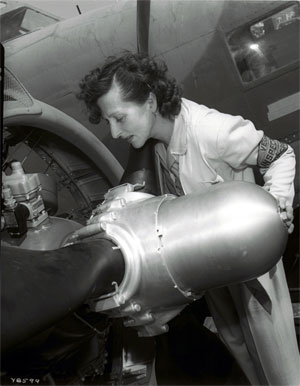All the day long whether rain or shine
she's a part of the assembly line
she's making history working for victory
Rosie the Riveter!
One of the most iconic images, spawned by this song:

This started in around 1939/1940, when American resources were starting to get sucked into World War II, and was in full swing by 1943. I had seen some pictures of women in the workforce from that time, and thought they were pretty neat.


But then, I read this week about the discontinuation of Kodachrome film, the world's first commercially available color film. In the late 30's/early 40's, it started reliably producing color photos, bringing the black-and-white world of the olden days:

into modern, full-color. The difference is breathtaking.

And so, I present to you some images of real-life Rosie the Riveters for your enjoyment, in brilliant Kodachrome color! Check out one in a machine shop,

a woman doing actual rivet-fastening work,

factory women taking their lunch break together,

and, as far as I can tell, the real-life Rosie the Riveter:

Hope you enjoyed the old-timey post today, hope you remember the innovation of Kodachrome film whenever you see color, and I hope you have a great weekend! I'll see you Monday!

What a great collection of pictures. So many interesting details.
Pity how far back we've slid since then.
Disturbing to see the lack of protection. So I guess we've come a long way too.
There is a large collection of historic photos being put onto Flickr by the Library of Congress:
http://www.flickr.com/photos/library_of_congress/
Hahaha - that reminds me that my grandma did an awful lot more for the war than my grandpa.
Grandpa was in boot camp, then sat idle in various camps for years, was then shipped to Australia for a few months and before he could be deployed the nuclear bombs were dropped on Japan. Grandpa wasn't even on any of the ships involved in the invasion of Japan - he was put on a ship and sent straight back to California.
@sili: I presume many of the photos are publicity photos and don't necessarily reflect reality.
Looking at the gal on the lathe with a milling head, she'd be retired with serious injuries before a year went by; she's certainly dressed to be dragged into the machine.
If you look at, say, a 1920s machinist's manual you'll see what the clothing and eye protection recommendations were then, and I can assure you it isn't what the gal in pink is wearing.
Have a look at the women having their meal - you can see many of them have their goggles strapped to their heads. The one with the red kerchief holding back her hair is wearing the commonly recommended garb for machinists in that era. Unfortunately I think that was a strong cotton fabric - which will seriously injure/kill you if it catches on the tools/work/machines; these days I see conflicting recommendations - long sleeves using a material which tears easily vs short sleeves (in which case you may have to tolerate hot metal chips raining on your arm).
Kodachrome was one of my favorites, but for the past 15 years I had been using Fuji's Velvia; at one stage I even used Velvia 50 which was always hard to get but was beautiful film. So bye-bye Kodachrome, but I hope color positive film remains available.
Thanks for the great post, Ethan! This is the first one I've sent to my Tweeps since most of them wouldn't appreciate the science topics.
An amazing generation that worked to gether to get the job done.
The bottom picture is a lathe, BTW. The second color photo would be Rosie. Check out those biceps!!!
I am a plumber in the Portland ,Oregon area. I did some work for a little old lady a couple of years ago that chatted to me while I worked.She told me about the war and the work she had done. It turns out she was Rosy the Riveter. I hadn't ever heard of her but when I told my mom about it she said she was famous.It's pretty cool that I got to meet here. Although I didn't realize who she was at the time. She's getting up there in years so I don't imagine she'll live too many more. She is a very nice lady.